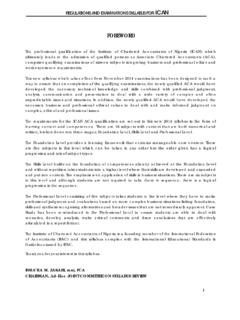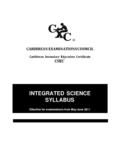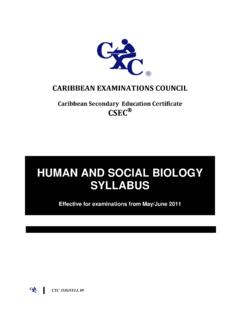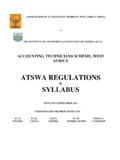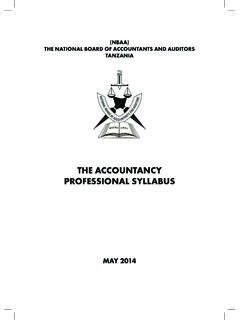Transcription of A GUIDE TO THE INTERNATIONAL BIOLOGY …
1 A GUIDE TO THE INTERNATIONAL BIOLOGY olympiad Edition IBO Coordinating Centre, Prague July 2015 Coordinating Centre of the INTERNATIONAL BIOLOGY olympiad , Prague July 2015 This version compiled by Shirley Lim and Mary Oliver, editing previous versions compiled by G rard Cobut, For all information concerning the IBO, please contact: Dr Tom Soukup Institute of Physiology Academy of Sciences of the Czech Republic V densk 1083 14220 Prague 4 - Czech Republic Tel +420 2 4106 2544 or +420 2 9644 2544 Fax +420 2 4106 2488 E-mail: or Faculty of Science Charles University Vinicna 7 12800 Prague 2 - Czech Republic IBO official Website: CONTENTS Foreword 4 1.
2 Introduction and History of the IBO 5 2. Structure of the IBO 7 3. Description of the Competition 9 4. Participation in the IBO 10 5. Financial Matters 13 6. How to set up a National olympiad 13 7. Rules for the IBO 15 Appendices I Theoretical Part of IBO 18 II Basic Skills of the Practical Part of IBO 26 III NBO description reference template 28 IV Declaration form for competitors 30 V List of member countries 31 VI List of GHS hazard pictograms 32 4 Foreword This guidebook offers information about the INTERNATIONAL BIOLOGY olympiad (IBO). It contains a description of the structure, organisation of the IBO, guidelines for participating and the Rules of the IBO, which are officially accepted and followed by all IBO members.
3 The GUIDE also includes a brief history of the IBO with an overview of information for new member countries. A separate document on the IBO website has a GUIDE for future host countries. The Appendices contain IBO theoretical and practical curricula accepted by member countries. 5 1 Introduction and History of the IBO 1. Introduction The INTERNATIONAL BIOLOGY olympiad (IBO) is a competition for secondary school students. Their skills in tackling biological problems, and dealing with biological experiments are tested. Interest in BIOLOGY , inventiveness, creativity and perseverance are necessary. Every member country sends four student competitors, who are the winners of the respective national competitions.
4 They are to be accompanied by two team leaders as representatives of each country. 2. Aims of the IBO The IBO is a competition for secondary school students who are interested in BIOLOGY . In bringing together gifted students, the IBO challenges, stimulates students to expand their talents, and to promote science as a career. The objectives of this competition are to: Stimulate active interest in biological studies; Promote networking and understanding between BIOLOGY students; Promote and exchange ideas about BIOLOGY education 3. History The first INTERNATIONAL biological competition between Czechoslovakia and Poland from 1985 to 1989 provided ground for the future IBO proper.
5 The positive experience during INTERNATIONAL Olympiads in other natural sciences and mathematics led to the idea of starting an INTERNATIONAL BIOLOGY olympiad . So UNESCO asked the former Czechoslovakia to take the initiative. Six interested countries (Belgium, Bulgaria, Czechoslovakia, German Democratic Republic, Poland and the Soviet Union) founded the IBO in 1989 (Prague and Brno) and participated in the first IBO, which was held in Olomouc in July 1990. Notwithstanding some initial difficulties, this olympiad was a great success and it was decided to continue with the IBO. In subsequent Olympiads the number of participating countries increased rapidly.
6 Introduction and History of the IBO INTERNATIONAL BIOLOGY olympiad 6 Year Country (City) No. participating countries 1990 Czech Republic (Olomouc) 6 1991 Russia (Machatskala) 9 1992 Slovak Republic (Poprad) 12 1993 The Netherlands (Utrecht) 15 1994 Bulgaria (Varna) 18 1995 Thailand (Bangkok) 22 1996 Ukraine (Artek) 23 1997 Turkmenistan (Ashgabat) 28 1998 Germany (Kiel) 33 1999 Sweden (Uppsala) 36 2000 Turkey (Antalya) 38 2001 Belgium (Brussels) 38 2002 Latvia (Riga) 40 2003 Belarus (Minsk) 41 2004 Australia (Brisbane) 40 2005 China (Beijing) 50 2006 Argentina (Rio Cuarto) 48 2007 Canada (Saskatoon) 49 2008 India (Mumbai) 55 2009 Japan (Tsukuba) 56 2010 Korea (Changwon) 58 2011 Chinese Taipei / Taiwan (Taipei)
7 58 2012 Singapore 59 2013 Switzerland (Bern) 62 2014 Indonesia (Bali) 61 2015 Denmark (Aarhus) 61 Immediately after the first olympiad , a Coordinating Centre was established in Prague and every November, a meeting of appointed coordinators (Advisory Board) assembles in this Centre to prepare new proposals and improve regulations, the content, and preparations of future Olympiads, etc. A list of countries involved in the IBO is presented in Appendix V. 7 2 Structure of the INTERNATIONAL BIOLOGY olympiad IBO bodies Coordinating Centre (CC) The CC acts as the secretariat of the IBO1 and fulfils the following functions: Provides information for all member countries and related INTERNATIONAL institutions (UNESCO, IUBS, etc.)
8 ; Coordinates the Advisory Board and the General Assembly, in a non-voting capacity; Ensures preparation and distribution of materials to these meetings; Promotes contacts with other non-IBO member countries; Coordinates the invitation of observers from other non-IBO member countries by the future host country; Accumulates relevant documentation about the competition; Registers and updates addresses of coordinators, their deputies, observers and of institutions taking part in the IBO; Collects materials and information regarding the IBO and other biological competitions, including descriptions of National BIOLOGY Olympiads or similar competitions used to select IBO competitors; Presents a yearly report about its activities and the financial situation at the General Assembly.
9 The CC fulfils these activities in collaboration with the IBO Steering Committee, IBO member countries and other organizations in accordance with the aims of the IBO. It organizes the annual IBO Advisory Board meeting. The CC will send an invoice to each country as a PDF by the end of March for members to pay the IBO membership fee. Steering Committee (SC) The SC is responsible for managing daily IBO events and procedures. It consists of five members plus the head of the CC. Members of the SC serve a four-year period and they can be re-elected2. Eligible candidates are country coordinators or team having been present for at least three IBOs before the election year.
10 Candidates can be nominated by a single country coordinator or declare their candidacy until the day of election. The election occurs during the General Assembly. Each country can vote for a maximum of four candidates in an anonymous poll (maximum one vote per candidate), electing those with the highest number of votes among all candidates. If two or more candidates have received the same number of votes, a subsequent vote is carried out anonymously until all positions have been determined. The SC starts its function officially on September 1st following the election. 1 It has been established at the National Institute of Children and Youth (NIDM) in Prague, Czech Republic and it is currently situated at the Faculty of Sciences of the Charles University in Prague, Czech Republic.
